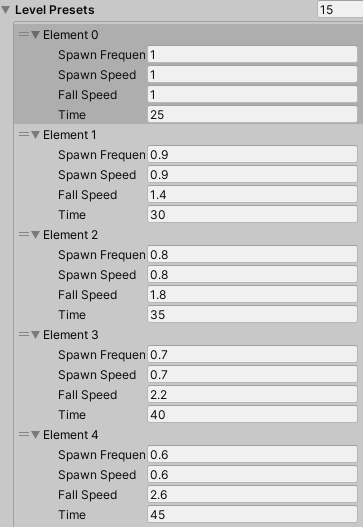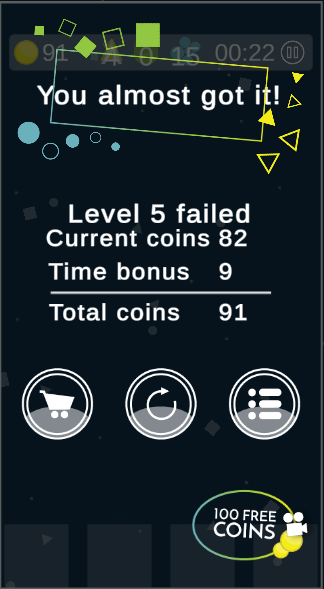Do you hear that? We are close. OhMyShape! is very close.
This Devlog number 3 for OhMyShape! is to discuss a couple of things:
- Current status
- The parts that have been most challenging for me
- The start of the closed beta
- The future
Current status
OhMyShape! is almost finished. This doesn’t mean that I can launch it on the Google Play Store yet, not at all. Not only do I need to polish details, add improvements, and test everything, but I also have some bugs still in the queue. However, at least what remains is identified, and anything that arises during testing shouldn’t take too long to correct.
So, if all goes as planned, we stick to the date, which one? None, because I only have an approximation I’ve been telling myself for months: end of August. I hope to meet it.
The parts that have been most challenging for me
Undoubtedly, this happens in all areas. There’s always something you struggle with and can’t get out, while other parts seem to come naturally.
Level Configuration
In OhMyShape!, one of the parts that has been hardest for me (and that I’m still not convinced by) are the levels. Or rather, the progressive difficulty of the levels. What’s easy and boring for some but balanced for others? What’s complicated but not impossible for some but impossible for others? If I make it easy, people will get bored and won’t play all the levels. If I make it overly difficult, many might try it as a challenge, but others will quit.

I still have a lot of playing to do, and above all, let others play it to continue configuring the levels.
Market Screen
Another aspect that has been challenging was the “Market”. The screen where the player can spend coins they earn playing to improve attributes of each shape. It’s a complex screen because it contains a lot of logic. I developed a system where you can add all the “options” you want as presets indicating the title, description, number of possible upgrades, the price for each upgrade, and whether or not it’s dependent on another option or if the user has the required level to display it.

All of this sounds great on paper, but when implementing, it’s quite complex, considering all the checks you have to do. For example, the power of the Square. The Square is an option that appears to unlock this Shape only when you are level 6 or higher. Until you unlock the square for a modest price of coins, you shouldn’t be able to acquire upgrades for the power of the Square. You have to constantly check the user’s money because you might have money for that option now, but not after buying an upgrade for the power of the triangle. And the buttons, if you don’t have enough money, appear disabled.
It seems easy, but it really isn’t. Then you have to calculate the number of possible upgrades, always keep track of which is the last acquired upgrade to display the price that corresponds to the next one, and the boxes marked as purchased.
All of this then translates into options to check during the game to prepare the player with everything they can do.
Level UI
At first, everything comes out quickly. But when you start adding UI, checks, and different actions, things get out of hand. Or at least that’s what happened to me, probably due to a poor initial approach. And then it gave me quite a headache. In the end, there are a few… layers? popups? panels? to show everything that happens.
- A tutorial panel the first time you play.
- A countdown before starting the level.
- A pause panel from which you can continue or reopen the tutorial, among other actions.
- A victory panel from which you can go to the next level and see the sum of coins earned, among other actions.
- A game over panel from which you can repeat the level and view the sum of coins earned, among other actions.
- A “Continue” panel where you left off when you die on a longer level and gives you the option to die altogether or continue if you watch an ad.
- A final panel for when you pass all levels.

The different options, playing with time, and the necessary flags so that depending on the panel the user can move or not, the spawner stops or not, the time doesn’t count, etc., have made this one of the most costly parts.
There have been more challenging parts, of course, like the power of the circle or the fact that elements that are not UI, i.e., playable elements, are resized in groups to look good on all mobile devices. But for today, that’s enough complaining.
Start of the closed beta
This week I start a closed beta with a group of people who volunteer to test the game and give me feedback. I will also play the game thoroughly to try to get everything possible out on my own. The goal is to detect bugs, gather possible improvements that make sense to apply now if they enhance the overall experience and the understanding of the game and fix them within two weeks (so I can rest a bit and focus on the VR Development Pathway).
The future
The near future is close (no shit). The plans are simple: fix what we get from the closed beta before the end of August and launch. Why before the end of August? Because that’s when my paternity leave and vacations run out, and I go back to work. So if I’m already struggling to find time now, I don’t know what will happen later.
Apart from releasing it for Android, my idea is to release a PC version. I will work on the adaptation to release it as soon as possible on a platform like itch.io (I doubt it’s a game that could step on a platform like Steam).
And, further on, there’s a level, 16, that has a “Coming soon”. My idea regarding this is to make a major update calmly, adding an Endless mode and integration with Google services to add a leaderboard. We’ll see if we get to all of this!
Until next time!
Leave a Reply